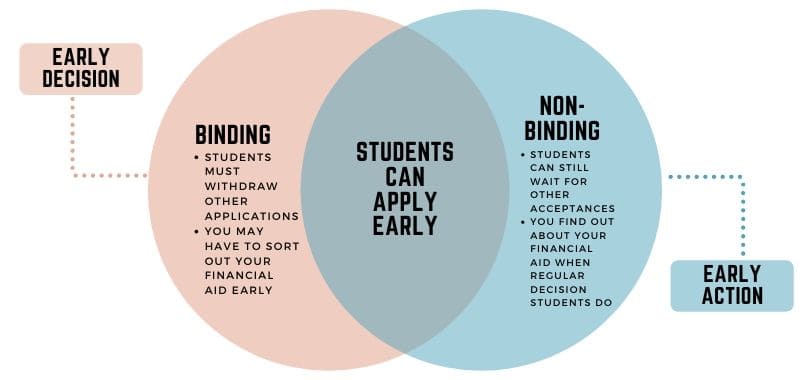Once you have decided which schools you will apply to, you’ll then need to decide which application deadline option is best for you: early decision vs early action or regular decision. They are vastly different and it’s important to understand the uniqueness of each college admissions process– or you might just apply under the wrong deadline. Doing so can have disastrous consequences. While a majority of students apply under regular decision, it is not always the best decision for every student!
It’s also important to note that not all colleges will have Early Decision or Early Action available to students. If you have any questions about the admissions process, reach out to the college in question as soon as possible.
Here’s the rundown of the different application deadlines.
Early Decision Vs. Early Action Vs. Regular Decision
Colleges and universities often have a few different application cycles available to students. The ones you’ll likely need to know include:
- Early decision. Early decision applications are usually due early to mid-November. Applications are binding agreements, which means if you’re accepted, you must attend the school except under certain circumstances.
- Early action. Early action applications are usually due early to mid-November. These are non-binding, so you’re welcome to send as many applications as you’d like. You don’t have to make a decision on a school until May 1st.
- Regular decision. Regular decision is when most students apply. The due date is usually January 1st, but some schools have different deadlines.
- Rolling admission. “Rolling admission” means the college accepts applications year round. They may have priority due dates that can impact your acceptance chances.
- Early decision II. Early decision II is the same as Early Decision, but usually has a due date of January 1st.
This table highlights the different dates you need to know about the various application types. Keep in mind that some schools may adhere to their own schedule. You should always check in with your potential colleges so you don’t miss any of these important deadlines.
[table “65” not found /]Unless you’re applying under Early Decision I or II or rolling admission, most colleges will require your decision by May 1st. However, there are exceptions to this rule for 2024. The National Association for College Admission Counseling (NACAC) has posted the new enrollment deadlines for 2024 on their website.
What is Early Decision?
Early Decision is the application process that allows you to apply early, but if you are accepted, you must attend the following fall. The application is binding and you can only back out if you have extremely specific circumstances. After an acceptance letter comes, you must withdraw any and all other applications to other colleges.
If you feel strongly this is the best-fit school for you and is absolutely your first-choice college, then applying as an Early Decision, or ED, student is a good idea. However, you must be positive that it is the school for you. If you’re even slightly unsure, you’re better off applying under Early Action or Regular Decision.

Here are some additional facts you should know about Early Decision applications:
- If you receive a rejection letter, you are free to apply to other schools under Early Decision II, rolling admissions, or regular decision.
- You may also receive a deferral which means you are free to apply to other colleges and are no longer bound to the contract. You will receive an acceptance letter or rejection later at a later date.
- You should not apply to more than one school under ED. Doing so could result in all acceptance letters being revoked.
- Early Decision deadlines are usually on either November 1st or November 15th, though the date can vary from school to school.
- You should hear back from the college by mid-December.
Pros of Early Decision
There are several benefits to applying under Early Decision, including
- You could increase your odds of acceptance.
- You get the application process out of the way (if you’re accepted).
- You’ll show the school you’re sincerely interested in attending.
- You’ll be able to start planning your move to college even sooner.
Cons of Early Decision
However, there are drawbacks to this application process, too.
- It is binding and if you have second thoughts after you’re accepted, you still have to attend. There are very few situations where colleges will release you from your contract.
- You’ll have to finish your application faster.
- Your senior year grades will not really play a factor in your application and schools will be looking at your junior year instead. This could really be a good or a bad thing, depending on the student! Or it may not make a difference at all.
- You are not able to review financial aid offers from other colleges since you’re required to attend. If you need financial aid, such as institutional grants, ED may not be the right course of action for you.
- Some ED schools will allow you to fill out an ED financial aid application that gives you a good estimate of what financial aid you will receive if you’re accepted.
What is Early Decision II?
Early Decision II is just like Early Decision but it is at a later date. These applications are generally due by January 1st (though the date can vary) and students will hear back from the college around mid-February. And like ED, these are binding. This is a good option if you’ve thought more about a particular college or you received some answers under Early Action
What Is Early Action?
Early Action (EA) is slightly different from Early Decision in that you still apply early and receive an admission decision early, but you do not have to commit to attending that college until a much later date.
This may be the right option for you if you have done your research and have found your dream school, but you want to keep your options open to compare admission and financial aid offers from other schools.
Here are some other facts and tidbits you should know about Early Action:
- Early Action applications are usually due on November 1st or November 15th.
- You should have an answer from the school by mid-December.
- Colleges usually expect a decision from you by May 1st (though the exact date can vary from school to school).
Pros of Early Action
As with Early Decision, there are a number of benefits to applying under Early Action:
- You show the school you’re extremely interested in attending, which could boost your acceptance odds.
- You may get your applications out of the way.
- It’s non-binding and you have plenty of time to wait for other offers, including financial aid offers, from schools.
- You can apply to as many schools as you want
- Since you don’t have to make a decision until May 1st (usually), you can apply to additional schools during regular decision applications.
Cons of Early Action
There aren’t many downsides to applying to Early Action, but there is one you need to know. For Early Action applicants, they do not often get financial aid offers with their acceptance letters in mid-December. You will likely have to wait until March or April to see these, which is also when regular decision applicants who were accepted will be receiving theirs.
So even if you’re pretty sure this is the school you want to attend, you might have to wait a little longer to write it in stone if you need the financial aid package. In addition, you’ll have to make your decision quickly if your education relies on that package – money can and will run out if too many people accept the school’s financial aid offer before you do!
Also, as with ED, your senior year will not have a ton of impact on your admissions chances as you would have only been a senior for a few months by November.
What is Restrictive Early Action?
Also known as Single-Choice Early Action, Restrictive Early Action is the idea that you will apply to one school and one school only under Early Action or Early Decision. There are two exceptions to this “only one school” rule though: you are free to apply to public universities or foreign universities.
Non-binding, Restrictive Early Action sends a very clear message of just how interested you are in the college in question. Your chances of receiving that acceptance letter could be higher. Not that some schools only offer Restrictive Early Action and not simply Early Action, such as Harvard.
What is Regular Decision?
Regular Decision is just like it sounds! Nothing early or different about it! Students can submit their applications by January 1st (though some schools do have different deadlines) and tend to hear back by March or April. Acceptance letters will include financial aid offers (if any). Accepted students generally have to make a decision on where to attend by May 1st.
Pros of Regular Decision
Here are the benefits of applying under Regular Decision:
- It’s non-binding.
- You have more time to research schools and complete applications.
- You can take last-minute ACT or SAT scores and include them with your application.
- More of your grades from your first semester of your senior year are taken into account.
- You can apply to as many schools as you would like under Regular Decision.
Cons of Regular Decision
The major downside of applying under regular decision is the fact that you won’t receive an answer in a couple of weeks. Applying under Early Action, Early Decision, or Early Decision II will have you knowing where you stand after only 4-6 weeks (unless your application has been deferred). Regular Decision applications, meanwhile, can take 2-3 months. This is due to the fact that most students applying to college will apply under regular decision. However, this does mean you will have less time to make a final decision on where you want to attend.
What are Rolling Admissions?
Rolling admissions are open year-round or almost all year-round. That means you can submit your application at any date within that period of time. Those who apply under this process will usually hear back between 4 to 6 weeks, but depending on the school, it may be sooner.
Even though Rolling Admissions may seem like they don’t have a deadline, you may have to submit your application by a particular date if you want to attend the following fall, for example. Some, on the other hand, will continue taking applications until their classes fill up. These schools also tend to have priority deadlines and financial aid deadlines.
Deadlines, response times, and admission decision deadlines vary quite a bit under Rolling Admissions.
So what’s right for you? Early Action vs Early Decision, Restrictive Early Action vs Early Decision II, Regular Decision, or Rolling Admissions? It’s important not to rush your choice and carefully weigh the pros and cons of each before submitting your application. Only apply under Early Decision if you’re absolutely sure you want to attend! If you’re having trouble deciding, make sure to talk to your guidance counselor about your options.
Did you know that College Raptor can help give you information on your admissions chances to thousands of schools? Our College Match tool allows you to input your academic achievements, interests, goals, and more to give you invaluable information when it comes to college applications.








Hi,
Do you suggest that I apply to the safeties early or reach school early?
Hello, Nivetha! Reach schools tend to be more expensive than safeties, so it can be a good idea to apply early to reach schools so you have more time to compare award letters, financial aid strategies, and scholarship opportunities. Hope this helps!
Hi! My daughter has a 3.45 gpa and 30 on act. If she applies ed and early action what are her chances to the below list of schools:
1. Tuft
2. USC
3. Pitzer
4. Georgetown
5. Barnard
6. Middlebury
7.nyu
8. By
9. Emory
10. Skidmore
11. Babson
12. George Washington
13.Uc’s
14. Swathmore
15. Northeastern
Is this a good list for her? She wants a mid to small size school preferably. She wants something not to far from a big city
She wants a school with a good international mix. A private school
How is this list and what would you reccomend? If any others
Prefferably east or west coasts or near cities with direct flights for international flights.
Hi, Surekha! That is an impressive list, to be sure. Luckily with College Raptor’s free match tool, you can discover your daughter’s acceptance odds to all of those schools (and more) by filling out a quick profile. Good luck!